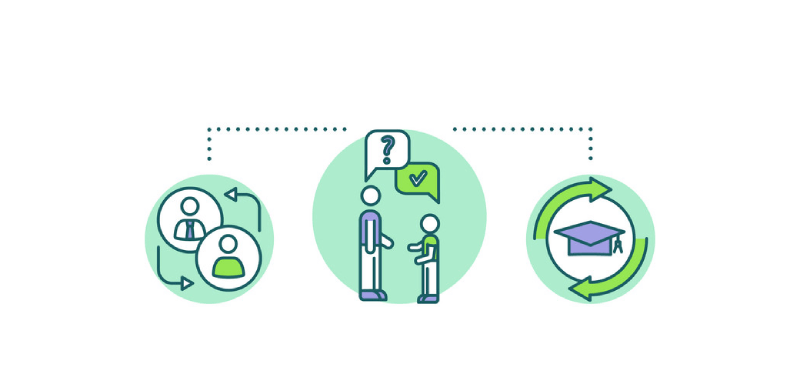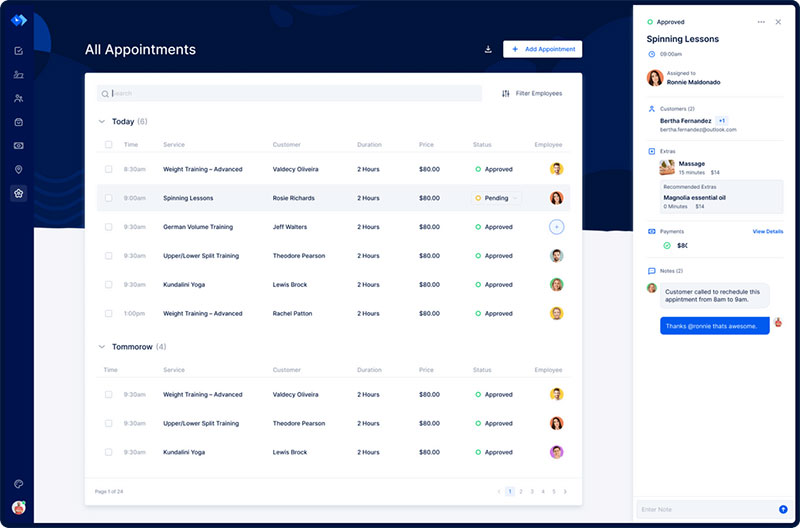For several reasons, today companies find it challenging to retain employees. Older workers are retiring, while millennials have the most potential to resign.
At the same time, entry-level employees tend to be younger and join departments with a significant generation gap. This situation makes it hard for them to connect and collaborate with senior colleagues.
Many companies are implementing mentoring programs to deal with today's workplace issues. These programs help to close the existing skills gaps.
In fact, evidence has shown that mentoring relationships form stable work teams and departments. They improve communication skills and produce future leaders.
Most organizations opt for a traditional mentoring program in which a senior leader or employee plays the mentor. The main goal of this program is for younger workers to learn new skills and have a smooth onboarding process.
But there is more to mentoring than the traditional approach. By fostering mentoring relationships with a different dynamic, businesses get even better results.
This article will explore the numerous benefits of reverse mentoring. You will learn how to foster these relationships within your company.
In addition , you will get a 7-step guide to building a successful mentoring program. First, read below to find out what reverse mentoring involves.
Reverse Mentoring Relationship - What is it?

The reverse approach represents an opposite experience to the traditional mentoring relationship. It is more experiential and less rigid, which fits the demands of the fast-paced modern world.
The junior employee guides the process and, as such, plays the role of mentor. They bring newly acquired knowledge, a fresh perspective, much-needed technology skills, and a more open mind. This switch of positions leads to the alternate designation of upward mentoring.
The goal is for senior team members to understand developments in the industry and learn new techniques, like digital skills. They also connect more with their organization and gain a deeper understanding of its progress and needs.
Doing so obliterates the idea that senior managers are inaccessible and arrogant. Instead, there is a sense of respect, belonging, and significance within all seniority levels.
Nonetheless, junior employees have the opportunity to relate directly with the management. They develop leadership skills and feel more connected to the company and its purpose.
Although older employees tend to be more experienced, age is not a determinant factor. What matters most is that the mentee is a more senior employee within the organization than the mentor.
Still, this formal program will be more successful if the match is between workers of different ages. They will have more to learn from each other and will produce better results in the long run.
This mentoring relationship enables mentors and mentees to grow together. They should feel valued and free to communicate different perspectives throughout the process.
The benefits that come from sharing knowledge and developing new skills extend to the company.
When and Why Should You Employ Reverse Mentoring Programs?
Knowing when to establish a mentoring program is crucial for it to have a positive impact. Consider the following questions:
- Are attrition levels rising? If so, why?
- Do senior executives have difficulty making strategic decisions? Do they keep up with technological advancements?
- Also, do they engage with junior team members or form a separate group?
- Are younger employees motivated?
- Do minority groups feel represented within the company? Are they as included and valued as other workers?
- What about company growth? Has it developed as expected, or is it becoming stagnant?
The answers will help you decide if a reverse mentoring program could improve your company culture. All of these aspects influence your business development and often dictate its evolution.
So if now is the time, start defining a clear strategy to implement your program as soon as possible. You must prepare in advance and be proactive to motivate others to join.
Think about the senior employees in your business. They will be the focal point of the reverse mentoring relationships. The program is, first and foremost, designed for them.
These executive mentees understand the business concept but might lack modern digital skills. Hence, as you outline your action plan, remember what makes reverse mentoring important.
It can help your senior leaders make trustworthy decisions and manage with more skill and confidence. Besides, junior employees will feel encouraged to use their expertise in the organization.
How to Employ Reverse Mentorship?
Reverse mentorship does more than answer common challenges of the corporate world. It can help your company reach decisive goals and continue moving forward.
You have already considered some of the benefits of reverse mentoring programs. Yet, because it is so impactful, it can apply to many different areas within your organization.
Below, you will find 10 ways to make the most of this method.
Introduce New Viewpoints
New technologies continue to reshape the way people live and work. They affect most common processes and even eliminate some.
For your business to succeed, you need to know which advancements relate to your industry. Besides, your workers must be open to implementing these modern means in everyday tasks.
Still, discussing digital topics with some of your more senior employees is a complex chore. That is where a reverse mentoring program is of help.
You can use junior employees to introduce new work philosophies and viewpoints. They will be keen to support you when you implement social media marketing and other modern digital skills.
A reverse mentoring program will also prepare them to teach others. They will create crucial strategies for their professional development.
Reinforce DE&I Measures
Diversity, equity, and inclusion (DE&I) are consequential subjects. Businesses today are more concerned with creating safe work environments for all employees.
Upward mentoring can have a paramount influence on organizations. It facilitates the implementation of measures that promote diversity within the workplace.
A mentoring program helps senior leaders understand the challenges their junior mentors face. They get first-hand knowledge of the opportunities, resources, and treatment they receive in the company.
Throughout the relationship, mentees learn about the perspectives and experiences of younger employees. They will become more aware of issues regarding minority representation and will be better prepared to approach them.
Even so, senior executives should actively promote diversity, equity, and inclusion. Not only is their influence more impactful than any other, but they also have the responsibility to set an example for other employees.
Your mentorship success story starts with a scheduling app to streamline your calendar
Staying organized has never been easier.
You can now manage your business and grow your brand with a single, powerful software that keeps all of your appointments in line, your clients organized and your business booming.
Trafft is perfect for business owners who need to streamline their booking experience both for their staff and their clients.
Trafft handles everything for you, even sending automated email or SMS reminders to your clients. No-shows? Not anymore!
The Trafft booking software adapts to different industries for a blissful online booking experience and employee management.
Want to know more? Check out Trafft's awesome features to see what you are missing.
Fight Generational Stereotypes
Stereotypes within your company can stop your workers from cooperating efficiently. A reverse mentorship program will help you approach the skills gaps within your departments.
The younger generation keeps up with the digital transformation affecting the industry. Yet, it is less motivated to fulfill everyday tasks. Still, a misconceived idea of the senior person can stop them from resorting to their colleagues for advice.
Employees of the older generation tend to adopt a defensive posture to the idea of cooperating with a younger person. They might keep up to date with the latest technology, but they are likely to maintain some distance from their junior colleagues.
To reap the advantages of a multi-generational workforce, you must fight these stereotypes. Doing so will also enable your workers to develop a more open mind.
Improve Millennial Retention
Younger employees, particularly Millennials, are the most likely to quit. They present several reasons like company priorities, plans, and standards.
To maintain Millennial talent, you must show that you care about their viewpoints and well-being. The reverse mentoring relationship offers an excellent opportunity to do that.
Senior management can show interest in younger employees. In addition, a millennial mentor will be able to understand the viewpoints of company leadership.
They will be more motivated to continue in their current roles. And they will bring more benefits to the operation with their expertise.
Boost Creativity and Innovation
Businesses must find innovative solutions for internal and external challenges to remain competitive. This creative process demands that employees keep an open mind.
In a reverse mentoring relationship, mentors and mentees get to know each other's viewpoints. Sharing expertise, ideas, and techniques fosters ideas that step out of conventions and put companies one step ahead.
Promote a Self-renewal Mindset
The truth is that having specific abilities is insufficient for employees to be ever-valuable. They must continue to develop as individuals and professionals.
A reverse mentoring program does more than allow participants to create new skills. It also promotes their maintenance and growth.
Your company can benefit from its employees' full potential by fostering a self-renewal mindset. The junior person feels heard and valued as they guide the relationship. Senior employees get many opportunities to share their expertise, despite having younger mentors.
Share Digital Skills

Right now, most processes include digital tools. It is crucial for companies that their employees are savvy in using these tools.
Technological advancements affect every single line of work. They keep improving business operations and demand constant updates.
Of course, the need for workers to be proficient in using technology will depend on their department and role. Regardless, they most likely will have to gain basic knowledge of some tools.
For example, some employees will adapt better than others when you install cloud-based computing. Their adjusting times will vary, and they will need different types of assistance.
A reverse mentoring program can help you smooth out the adjusting process to new work methods. A junior employee already skilled in using them can support their senior colleague.
Teach Business Competences to Junior Employees
A younger person fresh out of school can feel overwhelmed when adapting to the corporate world and its demands. At the same time, a new employee might find it hard to face a change of organization or department. After all, this shift will imply a new environment, team, and responsibilities.
In such cases, you can use a reverse mentoring program to support their onboarding process. Becoming mentors to their senior colleagues can help them adjust without feeling discouraged.
The mentees will convey the methods, approaches, and standards applied. Additionally, they will become a sounding board as mentees develop more confidence.
Increase Employee Engagement
Trends are changing, and company loyalty is not what it used to be. Younger employees now do not feel bound to their employers. Instead, they want to feel supported and valued.
Offering them the chance to become mentors provides the recognition they need to feel encouraged. Not only do they stick to their roles, but they also participate more actively in business operations and discussions.
Reverse mentoring promotes the creation of unique bonds that last for many years. These relationships provide the recognition and sense of belonging that all employees need.
Empower Emerging Leaders
The employees onboarding today are the leaders of tomorrow. Still, consistent and diligent leadership demands skills they do not yet possess.
Upward mentoring can be the key to helping younger employees develop the abilities necessary to take on managing roles. They regularly connect with senior executives and learn critical leadership skills from them.
Besides, the reverse mentoring process also builds trust, especially among mentors. As junior workers in the program develop their organizational skills, you will notice how their enthusiasm grows.
This newfound confidence helps them continue maturing and preparing to become exemplary leaders.
How Can You Build a Reverse Mentoring Program?
Building a reverse mentoring program seems complex, but it becomes easier with a strategic plan. The first step to succeed in this task is to establish a clear goal. It will serve as a guiding light for the whole operation. After this, there are 6 more measures you must take.
Set Specific Standards
You want to define precise parameters for your reverse mentoring program and its participants. You can choose the enrollment methods and set how to promote your program. Now is also the time to draft a schedule to meet your predefined goal.
Gain Leadership Support
Any mentoring program requires approval from managerial levels. Nevertheless, reverse mentoring falls so out of conventions that it is better to gain support from most executives.
As you pitch the program, remember your goal is for them to partake in it. They should act as examples to other employees.
Identify Potential Partners
The matching process is a crucial step for successful reverse mentoring. Regardless of whether you use mentoring software, mentors and mentees need to be able to identify with one another.
They must share core values, and their expertise, goals, and needs should be complementary. You can use a SWOT analysis to help you make more suitable choices.
Arrange for Proper Funding
The advantages of reverse mentoring largely outgrow the investment it requires. Still, there are costs associated that your organization will have to bear.
You can request an increase in Human Resources department funds to support the project. It would be positive to have an employee dedicated to managing the relationships. Plus, there might be more expenses if external mentors also follow the program.
Set a Regular Meeting Schedule
From the beginning, you must establish a regular meeting schedule. All participants should know its details, including progress goals and meetings.
It will be best for mentors and mentees to meet for at least one hour each week. Doing so will allow them to better understand and adapt to each other.
They will discuss current matters, challenges, and strategies. Meetings provide opportunities for developing new ideas and work concepts.
They can become practices for specific skills or counseling sessions. The participants might use reverse mentoring meetings to celebrate personal and professional achievements.
Monitor Progress
The last step is measuring progress. You will gauge it according to the standards and parameters you defined in the first and second steps.
You should also arrange opportunities for receiving feedback from the participants. Use these meetings to foster brainstorming and free sharing of opinions and ideas.
FAQs about reverse mentoring
1. What is reverse mentoring, and how does it differ from traditional mentoring relationships?
In reverse mentoring, a younger or less seasoned employee assumes the role of mentor for a more seasoned or older employee. The connection is distinct from conventional mentoring in that the mentor need not be more senior or experienced in the company. Instead, they might have expertise in areas like technology, social media, or cultural understanding that the mentee lacks.
2. What are the benefits of reverse mentoring for both the mentor and the mentee?
Reverse mentoring offers a special chance for the mentor and the mentee to benefit from one another. The mentee can learn about new trends, technology, and various viewpoints, while the mentor can develop important leadership and communication skills. It can also encourage a culture of respect and cooperation among workers from all generations.
3. What skills or knowledge should a mentor possess to be effective in a reverse mentoring relationship?
Strong communication and interpersonal skills, a solid understanding of technology, and a willingness to impart knowledge and experience are just a few of the knowledge and abilities that make effective reverse mentors. Also, they should have patience, be flexible, and be able to adjust their mentoring method to fit the needs and learning preferences of their mentee.
4. How can a company or organization successfully implement a reverse mentoring program?
A business or organization must first decide on the program's aims and objectives before it can successfully launch a reverse mentoring program. They should also establish clear rules and expectations for the relationship, as well as training and support for both mentors and mentees. They should also make sure that all employees who want to engage in the program can access it.
5. What are some common challenges that arise in reverse mentoring relationships, and how can they be addressed?
Communication failures, competing expectations, and age disparities in attitudes and work habits are common problems in reverse mentoring partnerships. To overcome these difficulties, it is crucial to create clear lines of communication and expectations, promote empathy and respect for one another, and give both mentors and mentees support and training.
6. Can reverse mentoring help bridge the generational gap in the workplace?
In the workplace, reverse mentoring can assist close the generational gap by increasing communication, understanding, and cooperation among workers of all ages and backgrounds. Also, it can give younger workers the chance to share their own knowledge and expertise while simultaneously benefiting from the experience and wisdom of their more seasoned counterparts.
7. What are some examples of successful reverse mentoring programs in companies or organizations?
GE's "Reverse Mentoring" program, which pairs senior executives with younger employees to learn about digital and social media trends, and PwC's "Reverse Mentoring" program, which focuses on assisting older partners understand the perspectives and needs of younger partners, are two examples of effective reverse mentoring programs.
8. How can a mentee best prepare for a reverse mentoring relationship?
A mentee should be open-minded, eager to learn, and willing to accept criticism and advice in order to best prepare for a reverse mentoring relationship. Also, they should be clear about their objectives and expectations for the partnership and be ready to put forth the time and effort necessary to forge a successful and mutually beneficial mentoring relationship.
9. How can a mentor build rapport and establish trust with their mentee?
A mentor should first invest the time to get to know their mentee and comprehend their needs and learning style in order to establish rapport and trust with them.
Also, they should communicate honestly and openly, be receptive to criticism and inquiries, and clearly define the relationship's parameters and expectations.
10. What are some potential drawbacks or limitations to reverse mentoring?
Communication failures, a lack of dedication on the part of either the mentor or the mentee, and the possibility that generational prejudices would damage the connection are all potential disadvantages or restrictions of reverse mentoring.
Defining clear expectations and boundaries for the connection, giving mentors and mentees assistance, and routinely assessing the program's efficacy, it is critical to solving these limitations.
To prevent the perpetuation of prejudices or biases, it is also crucial to make sure that the program is inclusive of and accessible to all employees, regardless of age or background.
Conclusion on Reverse Mentoring and Its Uses
Throughout this article, you have gotten to know reverse mentoring in detail. This approach is unlike the traditional method, yet just as advantageous, if not more.
You have learned about its advantages and when it is best applied. It brings a new perspective to your company, boosts creativity, and fosters cooperative teams.
Senior employees benefit from their younger colleagues' knowledge and improve their technological skills. Junior workers get to share their expertise and learn crucial leadership skills.
You also had the chance to understand how to employ reverse mentoring. You explored how it helps build a more inclusive and diverse workforce. And you got to see how your company can be free of generational stereotypes and attrition.
Finally, you received a 7-step guide to creating a successful reverse mentoring program. Remember that this project requires adequate funding. Also, all participants should know the standards and expectations.
Implementing reverse mentoring in your organization will offer you great benefits. Plus, with this outline, you will be able to set it up in little time and with maximum impact.
If you enjoyed reading this article about reverse mentoring, you should read these as well:
- Key Steps in a Good Mentoring Process (Must Know)
- How to Start a Mentoring Program In a Few Steps
- The Top Mentoring Best Practices that Guarantee a Success







